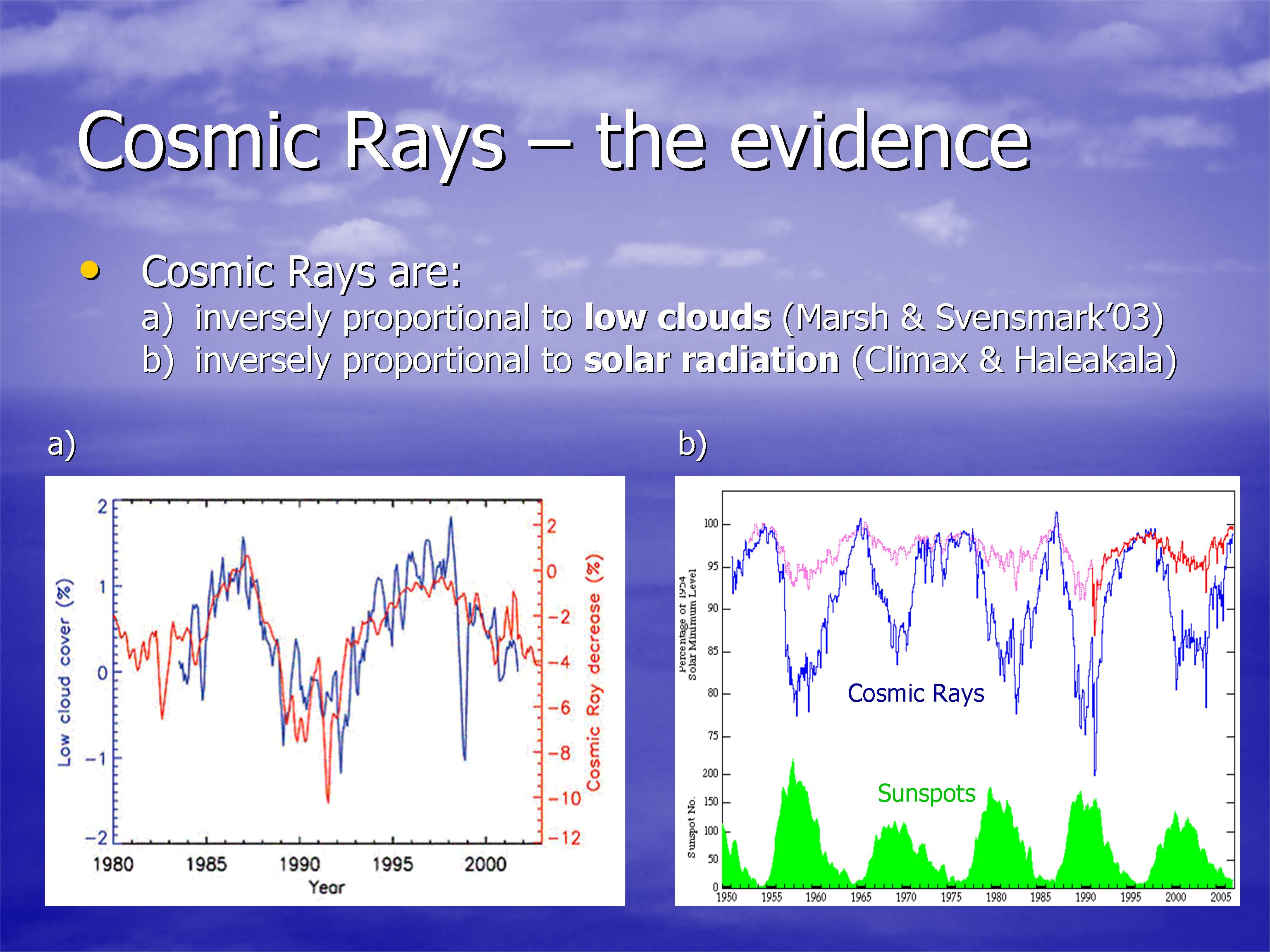According to the authors, "The effect of solar cycle perturbation on [cloud condensation nuclei] based on present study is generally higher than those reported in several previous studies, up to around one order of magnitude [10 times]...Our global simulations indicate that a decrease in ionization rate associated with galactic cosmic ray flux change from solar minimum to solar maximum reduces annual mean nucleation rates, number concentration of cloud condensation nuclei larger than 10 nm... by 6.8%, 1.36%...respectively. The inclusion of 0.2 °C temperature increase enhances the CCN [cloud condensation nuclei] solar cycle signals by around 50%."
"The most obvious way for warming to be caused naturally is for small, natural fluctuations in the circulation patterns of the atmosphere and ocean to result in a 1% or 2% decrease in global cloud cover. Clouds are the Earth’s sunshade, and if cloud cover changes for any reason, you have global warming — or global cooling."
This new paper finds annual mean cloud nucleation rates may vary 6.8% over solar cycles, far more than the 1-2% change in global cloudiness required to change global temperature.
The solar-cosmic ray theory of climate is only one of many solar amplification mechanisms described in the scientific literature.
Effect of solar variations on particle formation and cloud condensation nuclei
OPEN ACCESS FOCUS ON HIGH ENERGY PARTICLES AND ATMOSPHERIC PROCESSES
Fangqun Yu and Gan Luo
Show affiliations
Paper
The impact of solar variations on particle formation and cloud condensation nuclei (CCN), a critical step for one of the possible solar indirect climate forcing pathways, is studied here with a global aerosol model optimized for simulating detailed particle formation and growth processes. The effect of temperature change in enhancing the solar cycle CCN signal is investigated for the first time. Our global simulations indicate that a decrease in ionization rate associated with galactic cosmic ray flux change from solar minimum to solar maximum reduces annual mean nucleation rates, number concentration of condensation nuclei larger than 10 nm (CN10), and number concentrations of CCN at water supersaturation ratio of 0.8% (CCN0.8) and 0.2% (CCN0.2) in the lower troposphere by 6.8%, 1.36%, 0.74%, and 0.43%, respectively. The inclusion of 0.2 °C temperature increase enhances the CCN [cloud condensation nuclei] solar cycle signals by around 50%. The annual mean solar cycle CCN signals have large spatial and seasonal variations: (1) stronger in the lower troposphere where warm clouds are formed, (2) about 50% larger in the northern hemisphere than in the southern hemisphere, and (3) about a factor of two larger during the corresponding hemispheric summer seasons. The effect of solar cycle perturbation on CCN0.2 [cloud condensation nuclei] based on present study is generally higher than those reported in several previous studies, up to around one order of magnitude.



Thank you for this report. The main question now: "What fraction of the cosmic rays come from the Sun's pulsar core [1]?
ReplyDelete1. Oliver K. Manuel, “A Journey to the core of the Sun,” – Chapter 2: Acceptance of Reality"
I think the rays are coming from deep space as a constant and make it through the atmosphere at a higher rate when the sun's output is lower.
ReplyDeleteMost cosmic rays are from deep space, although a few are from the Sun
DeleteQuote: "... annual mean cloud nucleation rates may vary 6.8% over solar cycles, far more than the 1-2% change in global cloudiness required to change global temperature." I would add that's only the start. There are, in earth's history, so many more factors that could cause cloud nucleation rate changes: nuclear bombs spouting debris into the stratosphere, volcanoes and I presume a lot of "unknown unknowns" to quote Rumsfeld. What hubris to start modeling such a complex thing as earth's climate based on just the "known knowns" (and even getting these selectively wrong probably).
ReplyDeleteQuite right, and even greater hubris of the IPCC to claim an increased confidence of 95% in the climate model projections.
DeleteThere is a clear advantage that the coming years, 5-10, and that's a short term, what will turn out of the expected weak solar cycles 24 and 25. so there is no reason to panic like the IPCC tells us.
ReplyDelete